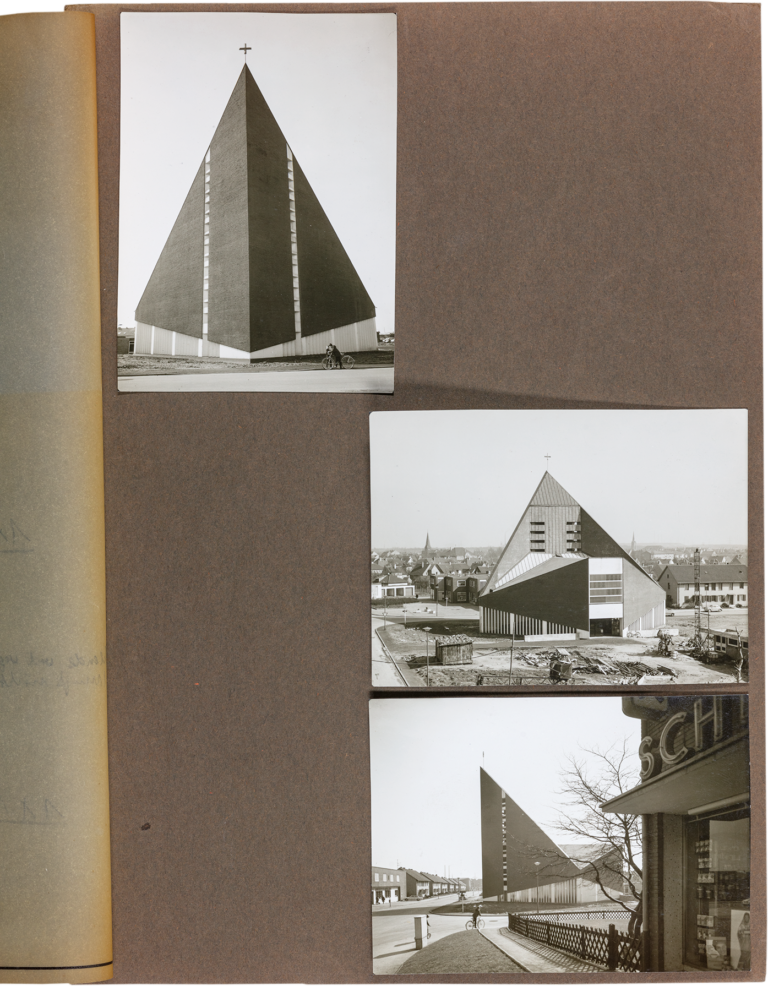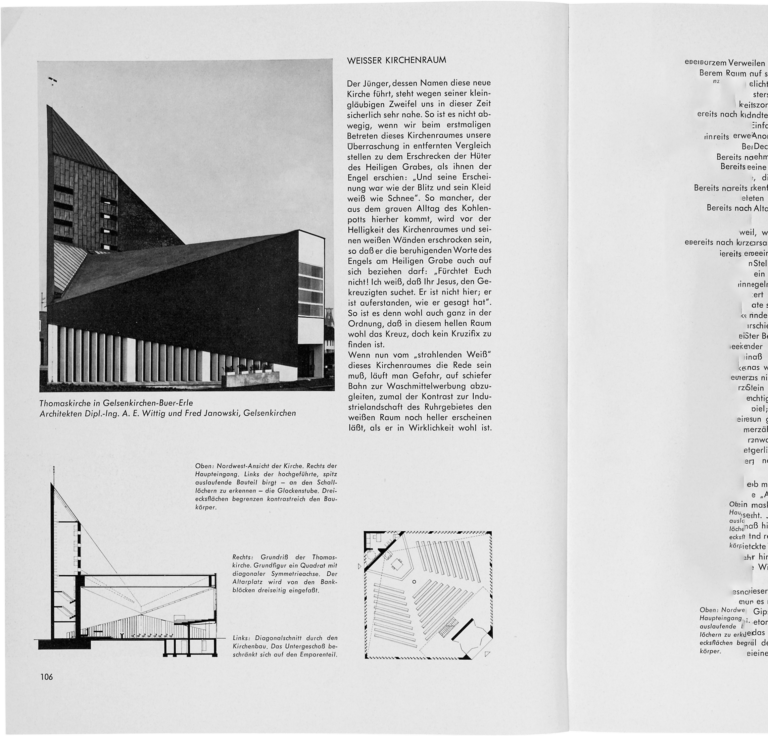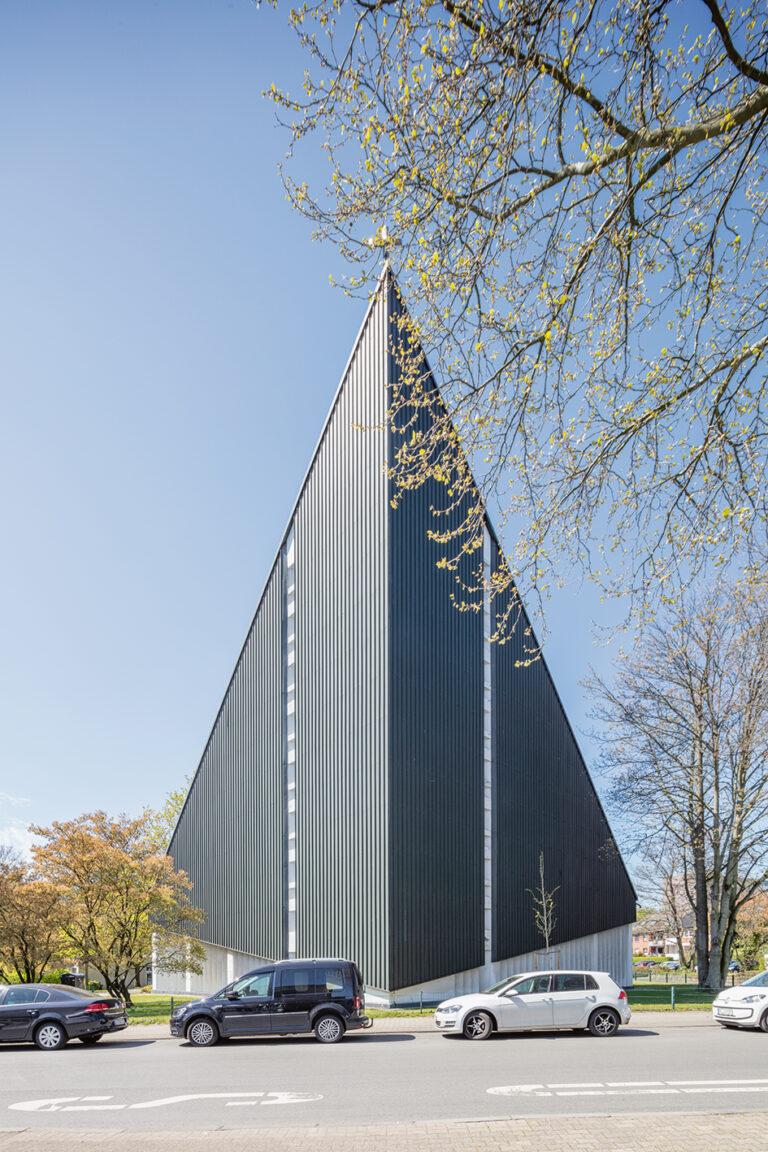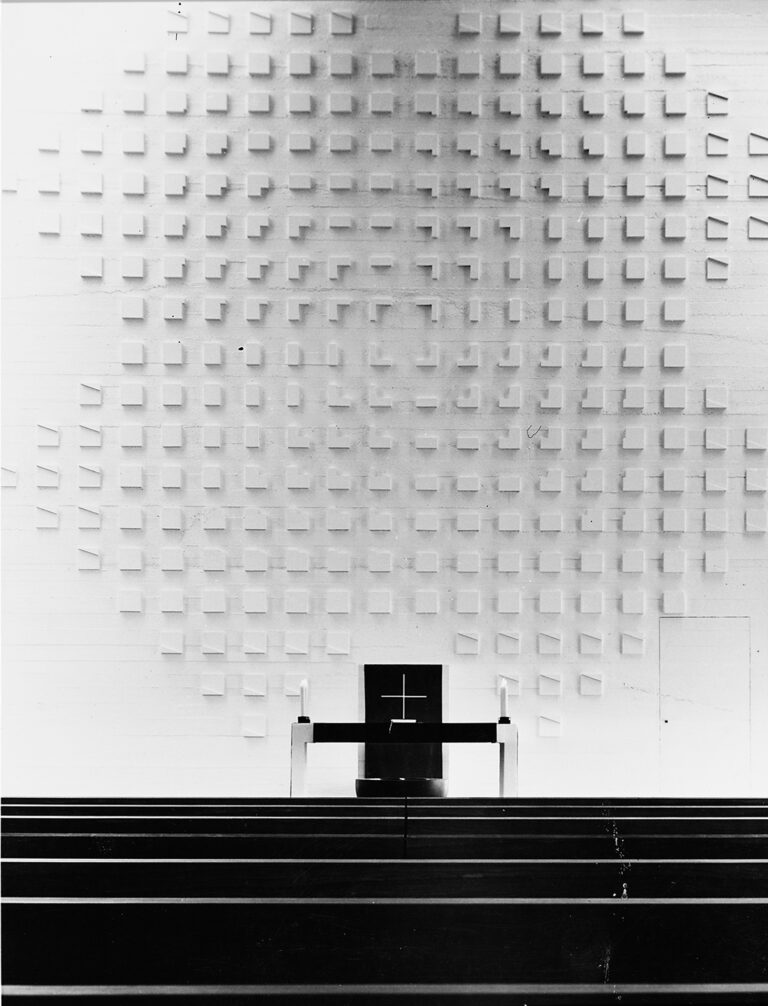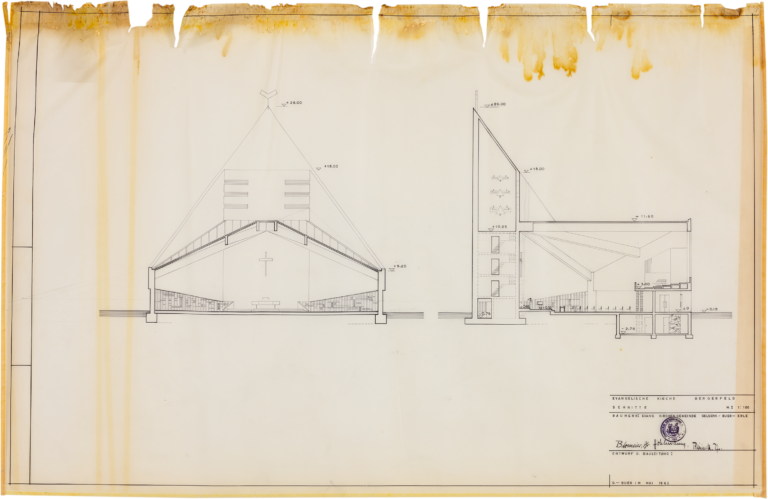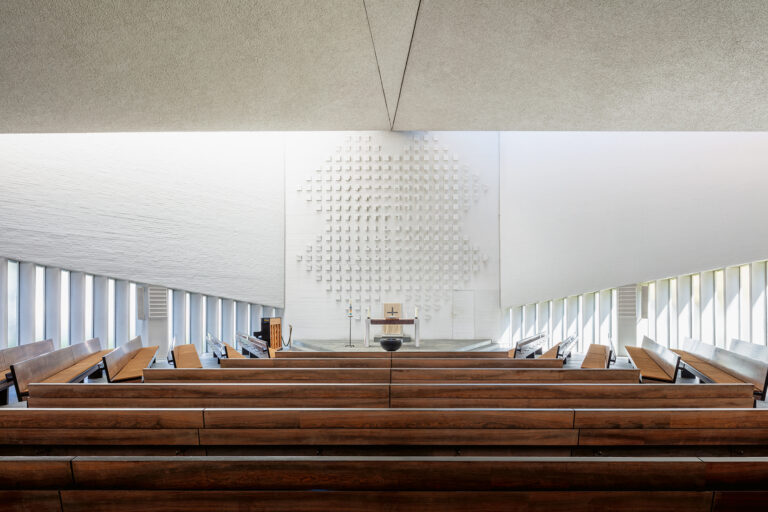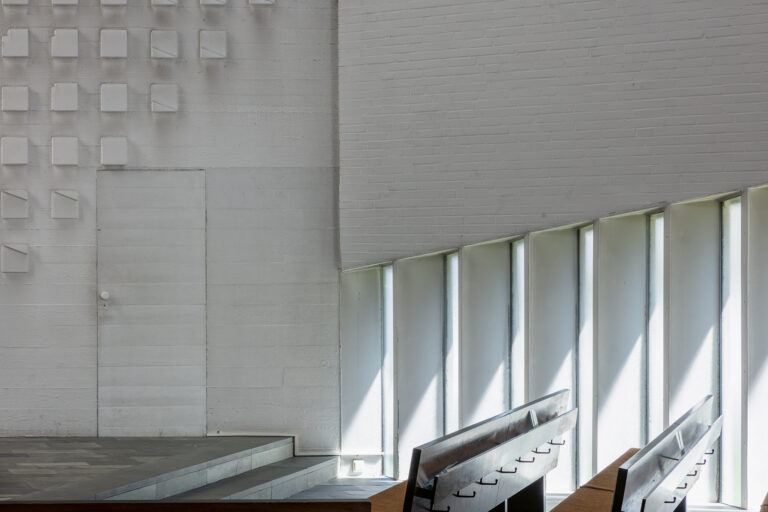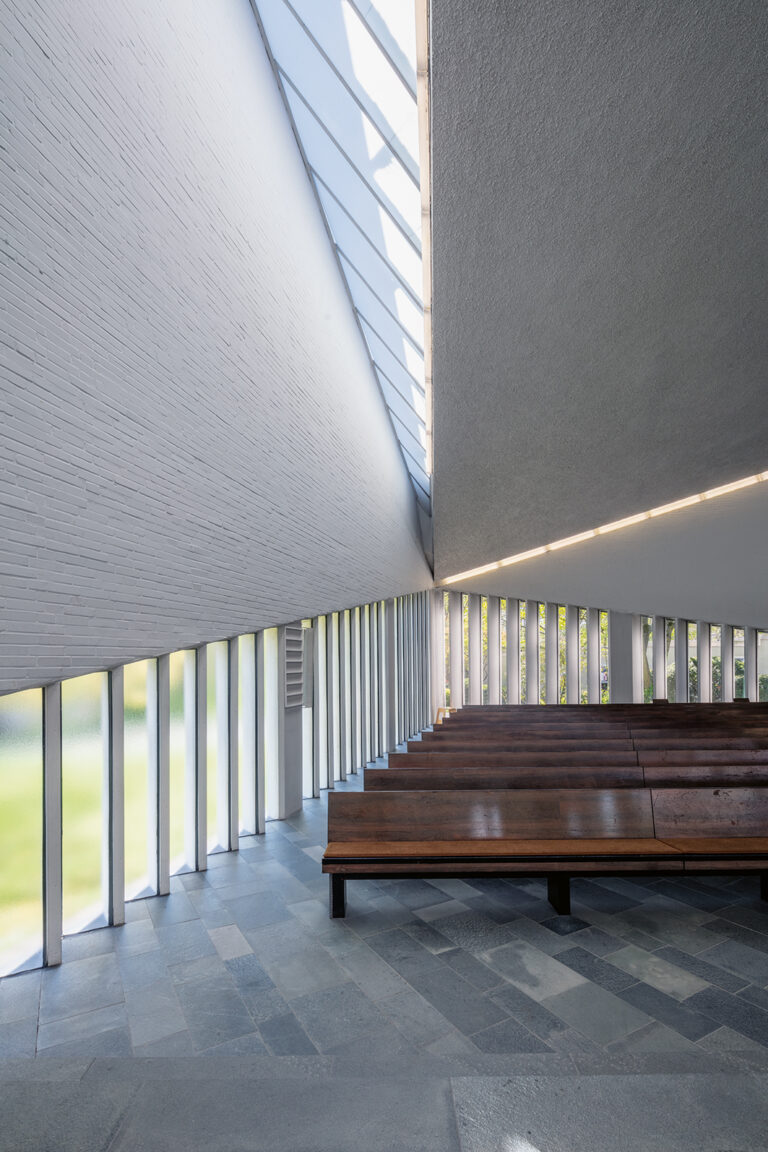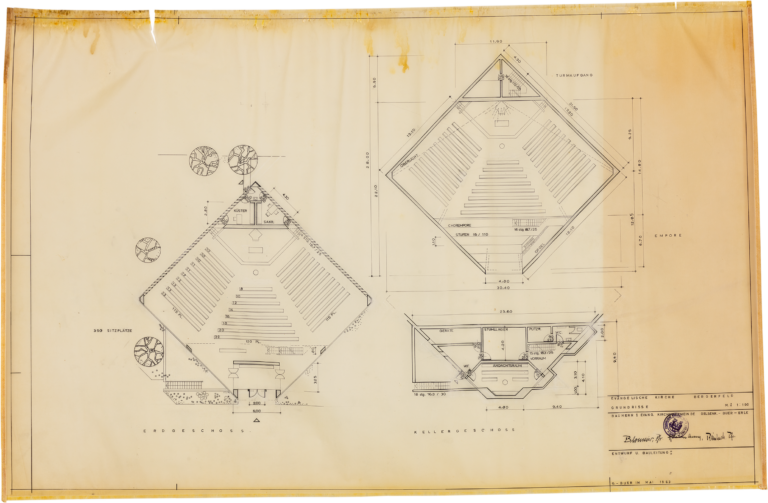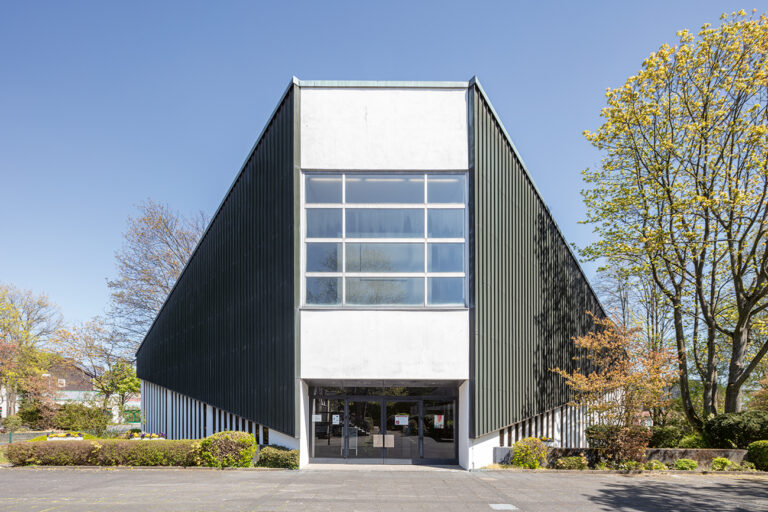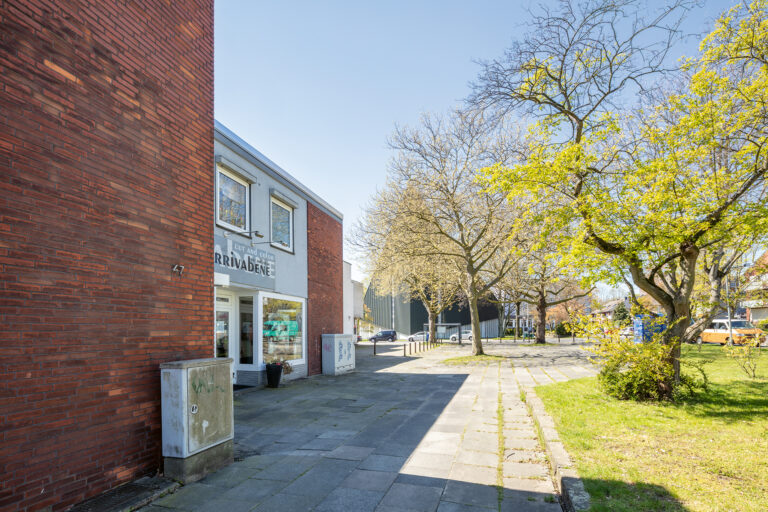Church in the square
Christos StremmenosWith a rotation through 45 degrees, a regular square can be reinterpreted as a rhombus. This complies with the laws of Euclidean geometry, which, with such a rotation around a point, shifts the quadrilateral polygon into the boundary zone of the sphere of rhombuses and unites two immanent readings in this shape: a regular square that abandons its rectangular integration and rotates into a rhombus; or a rhombus classified as a special case with four equal angles and sides of equal length, carrying a square within itself.
Geometrical ambiguity
The striking rendition of this geometrically incorporated ambiguity may also have been the inspiration for architects Albrecht Egon Wittig and Fred Janowski to position on the drawing paper the regular square, which forms the basis of their design for the Protestant Thomaskirche in Gelsenkirchen Buer-Erle, with a rotation through exactly 45 degrees. One might think that the placement of the floor plans of the ground floor and gallery level of the church building, drawn in ink on tracing paper and together with other drawings representing the design approved by the client’s agents in May 1963, was insignificant or only of superficial importance. Only this form of placement, however, decontextualises the shape in the way it exposes its fundamental essence in its ideal-typical effects on primarily neutral drawing paper. The two diagonals of the rotated square thus align themselves with the dominant axes of symmetry determining the shape, which at the same time take up an exactly parallel position to the edges of the sheet, like the needle of a compass, aligning the angular positions of the square on the paper like a rhombus. The angles pointing in four different pairs of opposite directions formally articulate exaggerated demarcations to something located outside the figure. Inwardly, the sides of the same angles generate complementary, niche-like introvertedness tapering towards the vertices.
To emphasise the ideal type of a regular square, on the other hand, it is essential that it is orthogonally embedded via its sides, which, parallel and opposite to the edges of the sheet, reproduce the figuratively generated outward boundaries in the semantics of the opposite and the frontal. Inside, too, the figure is fixed via similar connotations, which, with the inclusion of the flanking sides, generate frontal readings in four directions.
Independently of the projections and nuancing of the design via such squares and rhombuses in the third dimension, the properties described here are inherent in the geometrical shapes and come to the fore in the ideal-typical placement described. This becomes all the clearer when one compares the ground plans of the design drawing, executed on paper by the architects in the shape of a rhombus, with the setting emphasising the square in Stephan Hirzel’s article “Weisser Kirchenraum “, which appeared in the magazine “Kunst und Kirche” in 1966 after the completion of the Thomaskirche. The rectangular placement here seems to have been chosen not only for graphic reasons and in view of the justified type. The accompanying caption “Basic shape of the square with a diagonal axis of symmetry” suggests that the author approved of the rhombus being turned back to the original position of the square for layout purposes. In his continuing explanations and analyses in his text, Hirzel also only pays tribute to the underlying square, while mentioning the special significance of the diagonal. The presentation of the church thus lacks the geometric ambiguity that is so essential to the design, especially in its rhombic manifestations prominently presented in its rectangular.
Tent and nave at once
In their design, Wittig and Janowski adapt the characteristics of the underlying shape in many ways. By developing and aligning circulation and cubature along the axis of symmetry, they clearly and tangibly exaggerate its significance. If you walk along its continuation up the road “Am Fettingkotten” to the church, the building rises up along the rotated square to the apex of the basic rhombic shape like the bow of a ship. This positioning in the urban space truly encourages one to explore and walk around the abstract ship stranded here and rotated out of the rectilinearity of the urban grid. Viewed from the side, on the other hand, with its triangular surfaces rising in two opposite directions along the sides to the tips of the rhombus, the building looks not so much built of solid construction materials but with the lightness of objects folded out of paper origami-style. Thus, from a distance, one could imagine recognising a sharp-edged ship or a tent-like structure. If you walk around the building along the folded walls opening up into triangles, you come to the entrance situation on the side of the building facing away from the street, creating by truncating a corner from the volume. One might think that the architects sought to experience the building first in its cubature and to stretch the route into the church following the developed folds. This is reminiscent of strategies of gradual deceleration on the visitor’s approach, as is often achieved with forecourts, staircases, porticos or cloisters in front of sacred buildings.
A presentation sheet of brown matt photographic board, on which a brief sequence of photographs is mounted, seeks to plausibly depict these different readings of the cubature from various perspectives in the urban space. The photographs, taken from three positions at 90-degree angles to each other, impressively reproduce the different configurations described here along the two axes of symmetry of the underlying rhombus. The middle photograph, taken from a slightly elevated position at the entrance to the building, shows the structure rising above the roofs of the “Berger Feld” housing estate, still under construction in 1965. The bow of the ship, referring back from this angle to the “Fettingkotten” and recognisable as a bell tower, points to a square-defining complex on the opposite side, to which a row of shops composed of staggered cubes is attached. At this location, in a small roughly 45-square-metre shop at number 47, was the first provisional place of worship of the young “Berger Feld” community of the Gelsenkirchen Buer-Erle Protestant parish newly formed in 1961. On 30 July 1961, to the sound of Erle’s trombone choir, the first service was held in the “Berger Feld” shop church, which had been furnished through the efforts of members of the congregation. Until the Thomaskirche was built, the small provisional church did its job for four years and became the focal point and place of rest for the young parish district. From the shop window of the popular shop church, which had been well-known beyond the borders of Gelsenkirchen, the parishioners were able to observe the church gradually being erected into a folded nave on its rhombic base.
Church in the square
Upon its inauguration on 12.9.1965, they moved into a building whose interior had also been conceived out of the ambiguity of the mutually dependent shapes enclosed within one another. As a result of its rhombic shape, one visually enters and measures the space along the two axes of symmetry that define the longest lines constituting this figure and thus visually making the space appear deeper and wider. The first spatial impression is defined by the walls rising above the two sides of the opposite angle, which in this splayed arrangement form a welcoming gesture into which one is positively drawn on entering the church. Complementing the truncated entrance, the architects supplement the heart of the church with a white wall slab that functions as an altar wall. The room-high and square white wall reintroduces into the space the frontal, whose static and settling effect fosters a contemplative atmosphere. This impression is accentuated by a work by Heinz Nickel. From a basic cubic module, the artist modifies a varied palette of cubes and prisms, applying them to the altar wall in a grid pattern and combining them in relief to form a sculpture. From the seats of the pews arranged amphitheatrically around the altar wall and the main liturgical items, the radiant yet reposeful work of art is experienced in a variety of unique, finely nuanced moods of light and shade, depending on viewing angle and time of day. The individual white cubes protruding from the wall cast differently saturated shadows on the white wall, depending on the degree of modification and daylight intensity, and create unique plays of light and shade on the off-form concrete surface (#Church St Reinoldi; #Church of the Holy Blood). Depending on the lighting conditions and mood and formed from the gaps between the cubes, a cross can be recognised in the middle of the relief. Designed in this way, the altar wall has the effect of a museum art object that can be viewed and interpreted from all positions in the room, held at the sides by two walls in a welcoming gesture. The architects exaggerate the interplay of these two elements with a further device, breaking up the lower, triangular area of the two splayed walls into slender supporting pillars that break up the light, with glass surfaces in between (#Lamellar Model Church). The undermining of the solidity undertaken in this way accentuates the welcoming gesture, which now looks as if it is borne by light. The architects apply this process of dematerialisation in large-format triangles to all four walls enclosing the church.
Dematerialising incisions
A comparison of the completed structure with the sectional drawing released in May 1963 suggests that this conceptual optimisation was made at a relatively late stage in the design process. Clearly visible in the sections is that the dematerialising incisions were initially limited to the two walls flanking the altar wall. In the end, however, they were realised all around, which appreciably enhances the impression of sublimity. In this rendition, a light-borne structure now floats above a simple, regular square twisted out of the rectangular embedding of the urban texture. In the urban space, the incisions allow the lightweight nave, as if folded out of paper, to break the waves of light over the Berger Feld with its sharply rising prow, like a floating breakwater.
The present text was first published in: Hans-Jürgen Lechtreck, Wolfgang Sonne, Barbara Welzel (ed.): Religion@Stadt_Bauten_Ruhr, Dortmund 2021, pp. 198–213.
